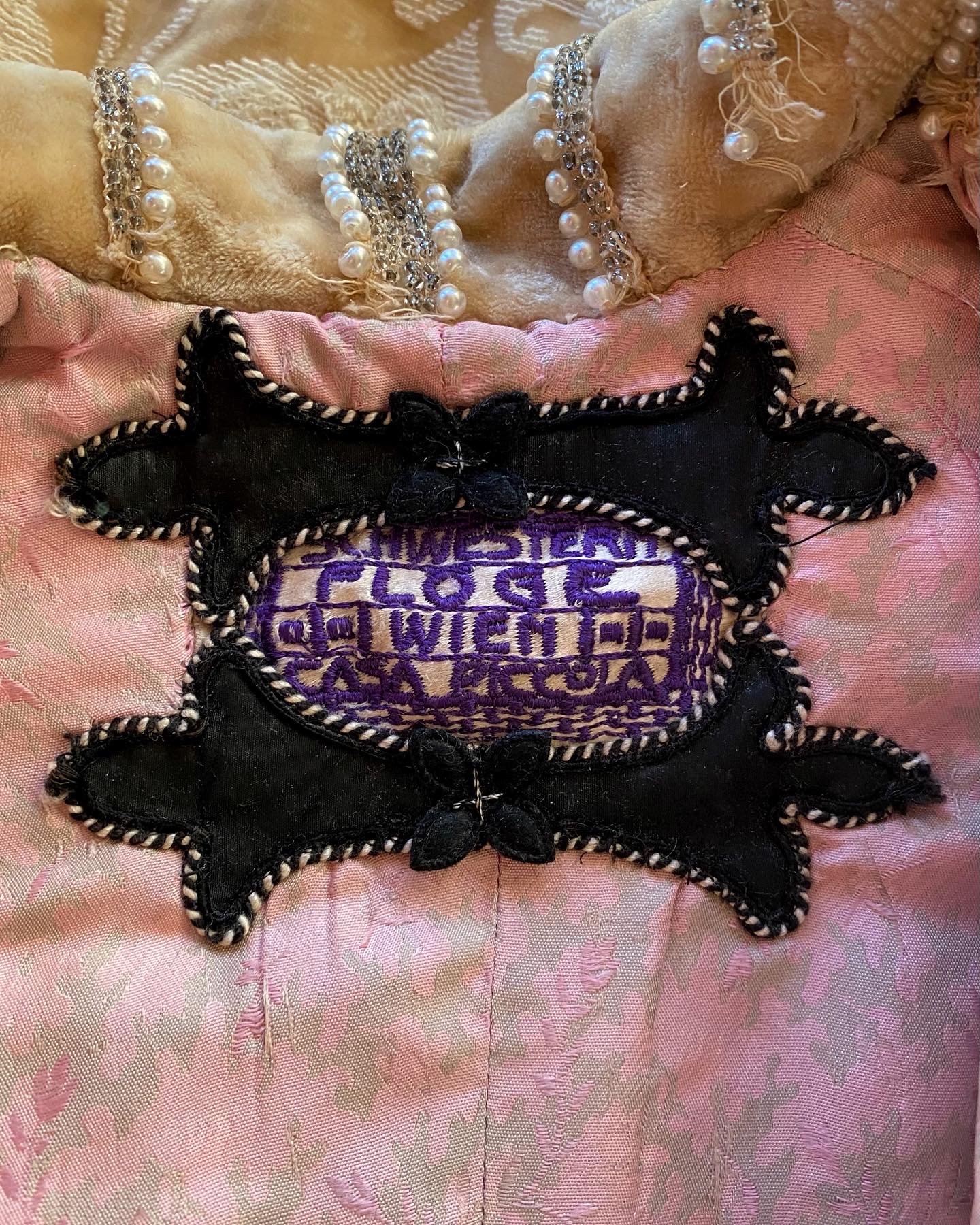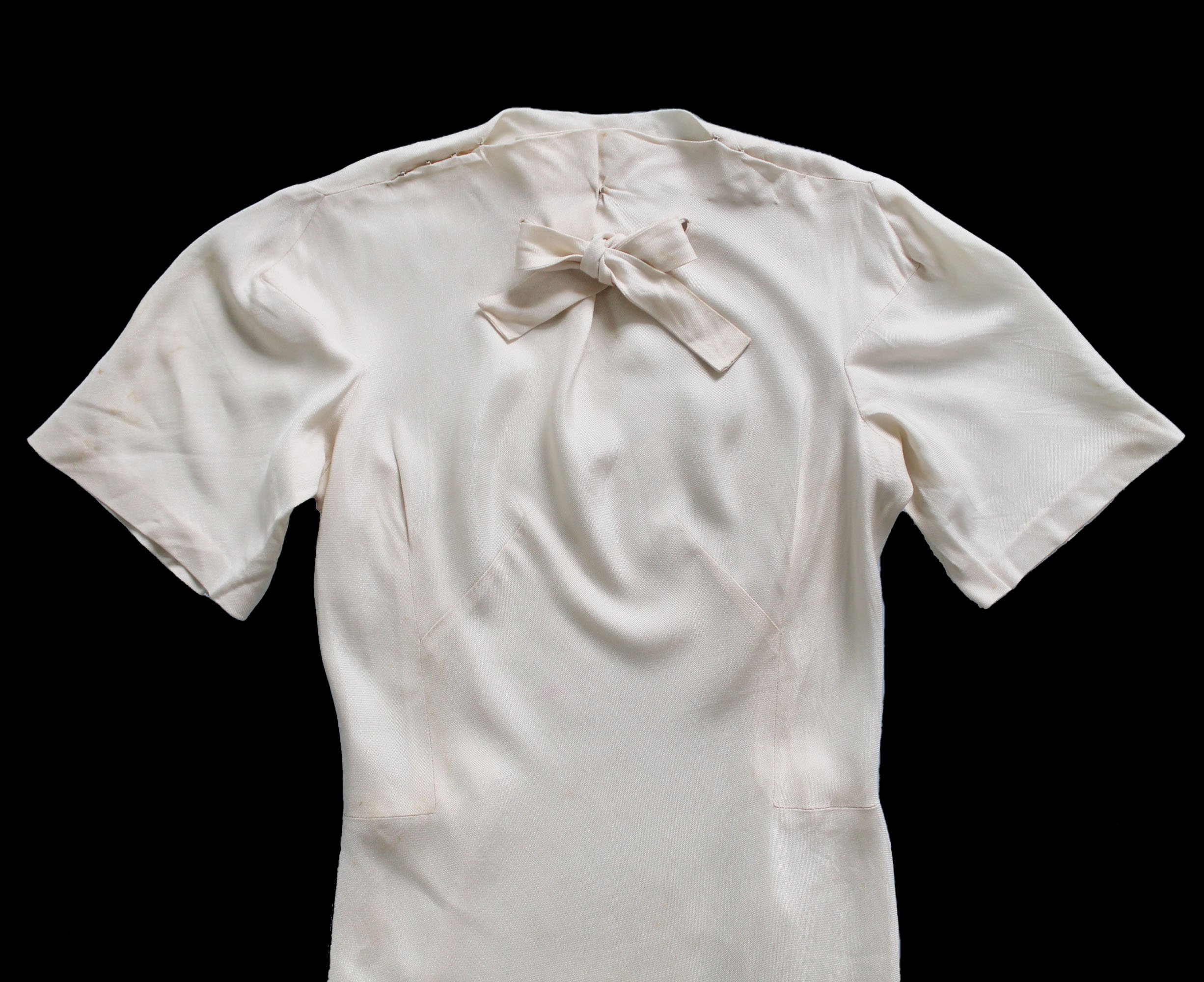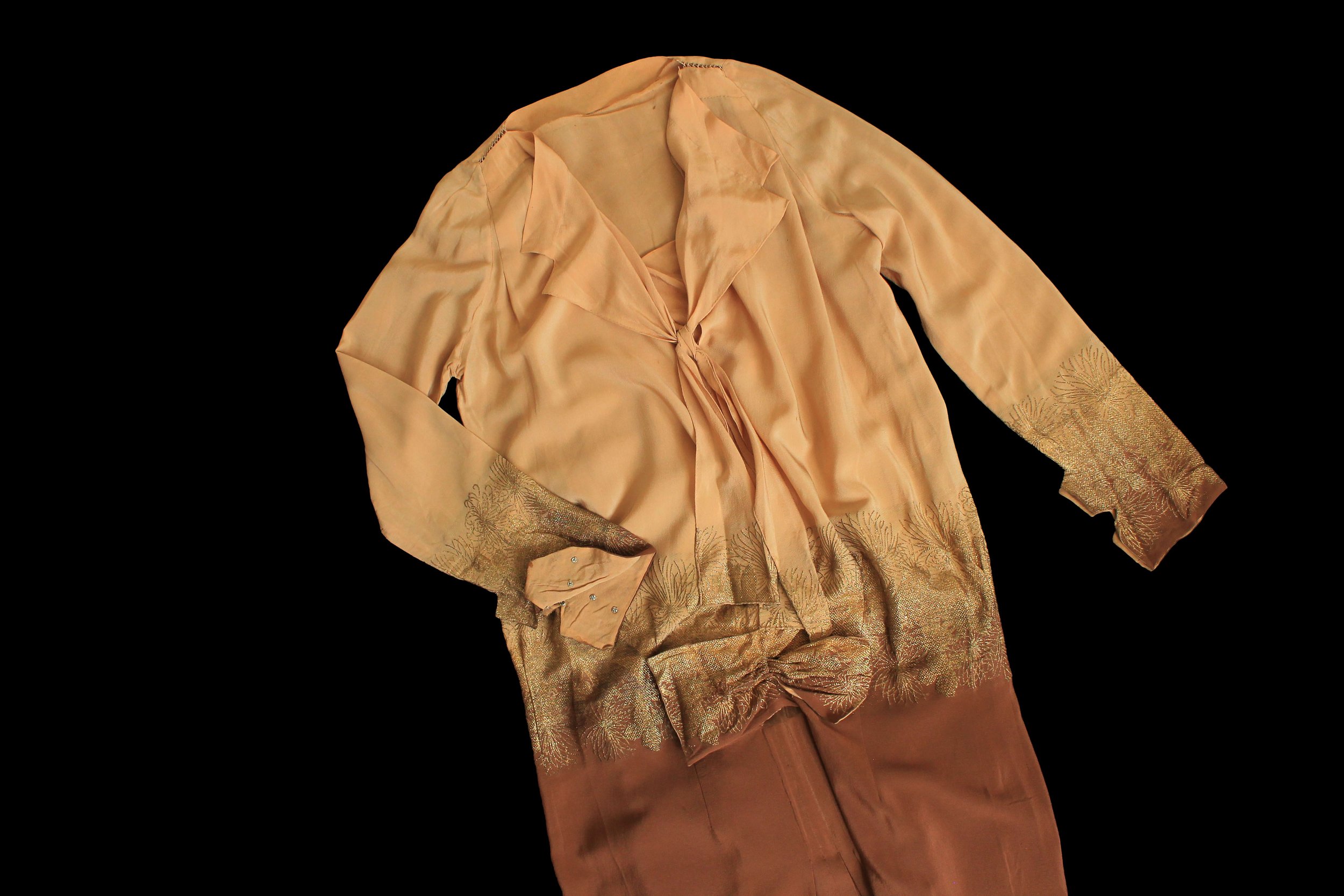garments of historical significance
Schwestern Flöge coat, 1910s. A very rare piece from Emilie Flöge's fashion label.
Interior label. Buttons bear Wiener Werkstätte marks.
Schwestern Flöge coat, 1910s. A very rare piece from Emilie Flöge's fashion label.
Silk georgette pajama jacket by Mary Nowitzky, 1924. Interior label.
Silk georgette pajama jacket by Mary Nowitzky from her first year of business, 1924.
Silk georgette pajama jacket by Mary Nowitzky from her first year of business, 1924.
Lanvin robe de style in her famous shade of Lanvin blue. Silk with metallic lamé and beaded tassels. Interior label with season, Summer 1922.
Another extant example of this dress resides in the collection of the Metropolitan Museum of Art.
A felt appliqué coat with stylized abstract flowers, designed by famed dollmaker Ars Lenci. A rather rare example of womenswear by Lenci.
Interior label.
A felt appliqué coat with stylized abstract flowers, designed by famed dollmaker Ars Lenci. A rather rare example of womenswear by Lenci.
Interior label.
A felt appliqué coat with stylized abstract flowers, designed by famed dollmaker Ars Lenci. A rather rare example of womenswear by Lenci.
Interior label.
Two piece screen-printed silk dress in “Betsy Ross - Liberty Bell” print by manufacturer H.R. Mallinson and Co. Unlabeled.
This print was part of the "Early American" series, released in 1929. Other examples reside in the collections of the Metropolitan Museum of Art , Rhode Island School of Design, and the National Museum of American History.
Two piece screen-printed silk dress in “Betsy Ross - Liberty Bell” print by manufacturer H.R. Mallinson and Co. Unlabeled.
This print was part of the "Early American" series, released in 1929. Other examples reside in the collections of the Metropolitan Museum of Art , Rhode Island School of Design, and the National Museum of American History.
Hand painted Wiener Werkstätte ladies shoes. These shoes are leather and completely hand painted with the "Osterglocken" (Narcissus) motif designed by Franz Von Zülow circa 1910/12. They have black and white striped enameled silver buckles, a design by Josef Hoffmann, sewn to the vamps. "Weiner Werkstatte" stamp on insoles and on reverse side of buckles.
Other extant examples of Franz Von Zülow's osterglocken motif for Wiener Werkstatte reside in various museum collections: The Cooper Hewitt (and drawing), the Metropolitan Museum of Art,
and Museum of Applied Arts and Sciences.
Edith Schiele's shoes in the same motif, reside in the Albertina Museum, Austria.
Another extant example of the enameled striped brooches by Josef Hoffmann resides in the Metropolitan Museum of Art.
Hand painted Wiener Werkstätte ladies shoes. These shoes are leather and completely hand painted with the "Osterglocken" (Narcissus) motif designed by Franz Von Zülow circa 1910/12. They have black and white striped enameled silver buckles, a design by Josef Hoffmann, sewn to the vamps. "Weiner Werkstatte" stamp on insoles and on reverse side of buckles.
Other extant examples of Franz Von Zülow's osterglocken motif for Wiener Werkstatte reside in various museum collections: The Cooper Hewitt (and drawing), the Metropolitan Museum of Art,
and Museum of Applied Arts and Sciences.
Edith Schiele's shoes in the same motif, reside in the Albertina Museum, Austria.
Another extant example of the enameled striped brooches by Josef Hoffmann resides in the Metropolitan Museum of Art.
Hand painted Wiener Werkstätte ladies shoes. These shoes are leather and completely hand painted with the "Osterglocken" (Narcissus) motif designed by Franz Von Zülow circa 1910/12. They have black and white striped enameled silver buckles, a design by Josef Hoffmann, sewn to the vamps. "Weiner Werkstatte" stamp on insoles and on reverse side of buckles.
Other extant examples of Franz Von Zülow's osterglocken motif for Wiener Werkstatte reside in various museum collections: The Cooper Hewitt (and drawing), the Metropolitan Museum of Art,
and Museum of Applied Arts and Sciences.
Edith Schiele's shoes in the same motif, reside in the Albertina Museum, Austria.
Another extant example of the enameled striped brooches by Josef Hoffmann resides in the Metropolitan Museum of Art.
Hand painted Wiener Werkstätte ladies shoes. These shoes are leather and completely hand painted with the "Osterglocken" (Narcissus) motif designed by Franz Von Zülow circa 1910/12. They have black and white striped enameled silver buckles, a design by Josef Hoffmann, sewn to the vamps. "Weiner Werkstatte" stamp on insoles and on reverse side of buckles.
Other extant examples of Franz Von Zülow's osterglocken motif for Wiener Werkstatte reside in various museum collections: The Cooper Hewitt (and drawing), the Metropolitan Museum of Art,
and Museum of Applied Arts and Sciences.
Edith Schiele's shoes in the same motif, reside in the Albertina Museum, Austria.
Another extant example of the enameled striped brooches by Josef Hoffmann resides in the Metropolitan Museum of Art.
A velvet evening coat with metallic stenciling by Maria Monaci Gallenga. The lining is stenciled as well.
Signed.
A velvet evening coat with metallic stenciling by Maria Monaci Gallenga. The lining is stenciled as well.
Signed.
A velvet evening coat with metallic stenciling by Maria Monaci Gallenga. The lining is stenciled as well.
Signed.
Metallic gold lamé and embroidered 1920s dress by Vitaldi Babani.
Unlabeled. A teal version of this dress, with its original matching coat, were exhibited in the 1993 exhibition "The Shapes of Fashion" sponsored by The Fashion Foundation of Japan. An additional, labeled variation of this dress was catalogued by Doris Raymond.
Metallic gold lamé and embroidered 1920s dress by Vitaldi Babani.
Unlabeled. A teal version of this dress, with its original matching coat, were exhibited in the 1993 exhibition "The Shapes of Fashion" sponsored by The Fashion Foundation of Japan. An additional, labeled variation of this dress was catalogued by Doris Raymond.
White afternoon dress with bias cut by Madeleine Vionnet. 1930s. Interior label.
White afternoon dress with bias cut by Madeleine Vionnet. 1930s. Interior label.
White afternoon dress with bias cut by Madeleine Vionnet. 1930s. Interior label.
A floral lamé split skirt tunic overdress attributed to Jeanne Lanvin.
Unlabeled. This attribution based on a matching dress ensemble identified by expert Thierry Grassat and auctioned via Adjug’Art Brest in 2024.
A floral lamé split skirt tunic overdress attributed to Jeanne Lanvin.
Unlabeled. This attribution based on a matching dress ensemble identified by expert Thierry Grassat and auctioned via Adjug’Art Brest in 2024.
Gabrielle Chanel silk dress with lamé chrysanthemums.
Unlabeled. This was part of a c. 1927 collection by Chanel in the chrysanthemum motif. Other labeled pieces from this collection reside in the collections of the Metropolitan Museum of Art and Kyoto Costume Institute .
Gabrielle Chanel silk dress with lamé chrysanthemums.
Unlabeled. This was part of a c. 1927 collection by Chanel in the chrysanthemum motif. Other labeled pieces from this collection reside in the collections of the Metropolitan Museum of Art and Kyoto Costume Institute .
Gabrielle Chanel silk dress with lamé chrysanthemums.
Unlabeled. This was part of a c. 1927 collection by Chanel in the chrysanthemum motif. Other labeled pieces from this collection reside in the collections of the Metropolitan Museum of Art and Kyoto Costume Institute .
Gabrielle Chanel silk dress with lamé chrysanthemums.
Unlabeled. This was part of a c. 1927 collection by Chanel in the chrysanthemum motif. Other labeled pieces from this collection reside in the collections of the Metropolitan Museum of Art and Kyoto Costume Institute .
Late 1920s dress fashioned in H. R. Mallinson screen-printed silk from its "American Indian" series, released in 1928. Likely commissioned from independent designer Walter Mitschke.
Other examples reside in collections of Rhode Island School of Design and the Museum of Fine Arts, Boston
Unlabeled.
Late 1920s dress fashioned in H. R. Mallinson screen-printed silk from its "American Indian" series, released in 1928. Likely commissioned from independent designer Walter Mitschke. Other examples reside in collections of Rhode Island School of Design and the Museum of Fine Arts, Boston.
Unlabeled.
Wiener Werkstätte silk shoes with heart-shaped cutouts, moiré ribbon laces, and Koloman "Kolo" Moser enameled rabbit buckles. Enameled buckles stamped with Wiener Werkstätte marks on undersides.
Other examples of Moser's enameled rabbit design reside in the collection of the MAK museum ( and 2).
Wiener Werkstätte silk shoes with heart-shaped cutouts, moiré ribbon laces, and Koloman "Kolo" Moser enameled rabbit buckles. Enameled buckles stamped with Wiener Werkstätte marks on undersides.
Other examples of Moser's enameled rabbit design reside in the collection of the MAK museum ( and 2).
Wiener Werkstätte leather shoes with Koloman "Kolo" Moser enameled animal buckles. Enameled buckles stamped with Wiener Werkstätte marks on undersides. Shoes stamped Wiener Werkstätte on insoles.
Other examples of Moser's enameled design reside in the collection of the MAK museum ( and 2).




































